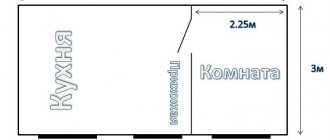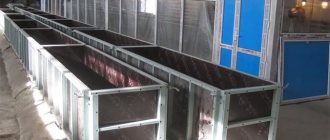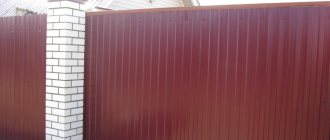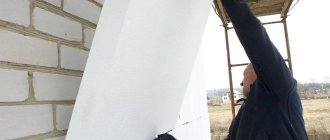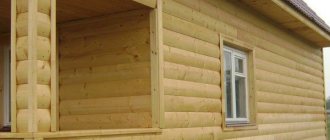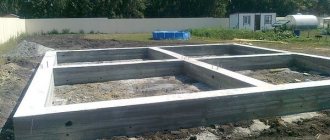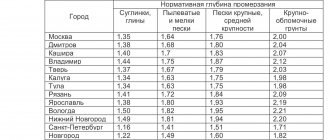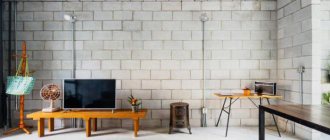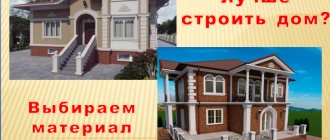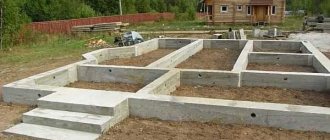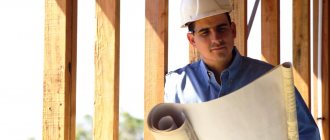Technical parameters of block elements
Building a house from blocks has always aroused the interest of users
If you rely on the price and aesthetics of the material, you can also build a house from blocks with your own hands, but no one can tell you how long the building will last. Therefore, you need to rely on the following indicators:
- Thermal conductivity. The lower the indicator, the higher the energy savings, which means the walls can be thinner;
- Strength. This means the ability of the material to withstand compressive loads;
- Frost resistance. Indicated by the number of freezing/thawing cycles without the product losing its exceptional qualities;
- Volume weight. Determined in kg/1m3, depends on the density of the material and is needed to calculate the strength of the supporting base;
- Moisture resistance. This is a parameter of hygroscopicity, that is, the moisture absorption of the product - the lower, the better;
- Vapor permeability. Responsible for the formation of condensation in the room and removal of excess moisture;
- Fire resistance, fire safety;
- Soundproofing qualities.
The size range and environmental friendliness of materials are also taken into account without fail. The first indicator is responsible for the variety of elements, which means the ability to translate any forms and projects into reality. The second is for the safety of the product for the health of all residents of the house. And not least of all, the price of the product and the efficiency of building construction play a role in the choice.
Concrete block façade painting
After sealing the seams and plastering the window slopes, they begin to paint the outer walls with facade paint. To paint the walls, you can use any façade paint from well-known manufacturers. The color is chosen according to the taste of the home owner. Light, rich traditional tones from yellow to white look especially advantageous. Corner parts should be painted in a different color, contrasting with the color of the wall.
About the choice of paint and painting methods, read: “Painting the facade, exterior walls of a house with your own hands”
Watch the video and admire how the master masterfully lays besser blocks.
⇆
More articles on this topic
- Home mini sauna in the bathroom of an apartment or house
- House, wall made of large-porous expanded clay concrete blocks
- Heating a private house with a wood-burning solid fuel boiler
- House with monolithic walls made of large-porous expanded clay concrete
- How to install a plastic window in a house correctly according to GOST
- Interior decoration of house walls made of aerated concrete, gas silicate
- How to properly make natural ventilation in a private house
- How to make the right concrete floor in a wooden or frame house
Foundation blocks
The composition of the FBS block is heavy grade concrete, which is characterized by increased strength and resistance to various types of influences.
The composition of the FBS block is heavy grade concrete, which is characterized by increased strength and resistance to various types of influences. Most often used when arranging strip foundations and is indicated for heavy massive buildings. However, when planning the basement level, such blocks are also good and are an alternative to a strip base, benefiting in terms of economy and speed of construction.
Important! To increase strength, frame reinforcement is used.
In addition to standard FBS, the following are used:
- FBV - elements with cutouts, through which it is convenient to lay communications;
- FBP are hollow block bars used to lighten the weight of a building or to equip load-bearing wall panels. They have improved thermal insulation qualities.
Advice! The use of foundation blocks will require the use of technology, since it is physically impossible to lift some elements yourself.
Creating a block base has many advantages:
- Construction of a house regardless of the seasons;
- The lack of time for the structure to mature and the possibility of erecting the box immediately upon completion of work with laying the foundation speeds up the construction period;
- Reduced workload due to the lack of formwork, reinforcement frame and mixture pouring.
Important! It is allowed to create a block foundation on any soil except heaving soil.
Low-rise block houses
Low-rise buildings, according to the generally accepted classification in Russia, are buildings with a height of 1-2 floors. Most “private” houses (cottages, townhouses, mansions, flathouses and duplexes) are considered low-rise. The peculiarity of such buildings from the point of view of the use of building materials is that most of the work on building a house can be performed by a person without special equipment.
All low-rise residential buildings are divided according to space-planning types into:
- single-family (individual);
- semi-detached (paired);
- four-apartment (blocked);
- multi-apartment (sectional).
The list of the most common building materials for the construction of low-rise buildings is as follows:
- brick;
- tree;
- building blocks;
- SIP panels.
We are interested in building blocks. Different composition of materials, different sizes, different prices - all this abundance of characteristics allows you to make the choice as optimal as possible. Let's look at the main types of building blocks:
- aerated concrete;
- foam concrete;
- ceramic;
- arbolite;
- expanded clay concrete.
Cellular blocks for building a house: advantages and disadvantages
Each material is successfully used to build a house from blocks
This type combines three types: aerated concrete, foam concrete, gas silicate blocks. Each material has been successfully used to build a block house, but it is difficult for a non-specialist to determine the characteristic features of the types. Let's look at the fundamental differences.
Foam and aerated concrete blocks
Materials vary according to the production method.
To form foam, a foaming agent is used, resulting in an element with a closed internal structure; for gas, a chemical reaction is used to form an open-shaped structure. Making a block can be one of two ways: Building a house from gas silicate blocks with your own hands
- Pouring the mixture into a mold made for small-sized elements;
- Pouring a monolithic piece and then cutting it into segments.
Foam concrete blocks are inferior to aerated concrete in terms of material shrinkage and increased level of hygroscopicity; moreover, aerated concrete is considered better in terms of thermal insulation qualities.
Technological features of the construction of houses from foam and aerated concrete blocks
The main advantage of the material is that you can build a house yourself
The main advantage of the material is that you can build a house yourself. In this case, you don’t need to have a lot of experience. The accuracy of shapes and sizes, the determined class and variety of element options help to select the material for any type of load-bearing structure. The blocks are held together with ordinary cement mortar or adhesive.
Advice! If you buy glue, it is much easier to adjust the shape of the house vertically and horizontally.
Positive and negative qualities of gas and foam concrete blocks:
- Good permeability of wall structures;
- High energy saving rates;
- Sufficient load-bearing capacity of each block;
- Fire resistance;
- Environmental friendliness;
- Durability;
- Frost resistance.
Important! Autoclaved aerated concrete allows up to 100 defrosting and thawing cycles.
These were the pros and cons:
- High hygroscopicity, and if you choose aerated concrete, the higher the density of the material, the higher the absorbency;
- Cold bridges reduce energy savings.
It is possible and necessary to build from blocks of this type if you think about the heat and waterproofing. Added to the advantages are overall savings: on materials, foundation construction (the light weight of the blocks reduces the requirements for the load-bearing capacity of the foundation), and the use of specialist services. But the video will show the general process of building a house from blocks.
Gas silicate blocks
Cellular structure material with high thermal insulation properties, produced by autoclave
A material with a cellular structure with high thermal insulation properties, produced by the autoclave method. It is made from the same raw materials as aerated concrete, but the difference is in the larger proportion of lime. It is this additive that causes controversy about the harmfulness of the product, but people have been whitewashing their houses for many years in a row and use this method to this day without experiencing any particular inconvenience.
Important! The highest load-bearing capacity allows you to build houses up to 5 floors, but the material has low bending strength. Therefore, the requirements for the foundation have been increased: a monolithic foundation will be the best option if you want to build a house from gas silicate correctly and for a long time.
The advantages of gas silicate are not limited to high performance - the material has an extremely low price, and the possibility of arranging a load-bearing wall in one row at latitudes of positive temperatures also adds to the product’s popularity. However, if there are frosts, gas silicate elements need additional insulation. Moreover, it is best to combine the process with waterproofing due to the high absorbency of the blocks.
Advice! When planning to build a house yourself, you should pay attention to the density indicator, especially if it is a two-story building - the best indicator is D 400-D 700. Ideal geometry, durability, frost resistance (up to 100 cycles) and high load-bearing capacity are clear advantages in favor of choosing gas silicate .
Materials used to construct the walls of a block house
We build from foam concrete blocks made in full compliance with the instructions of GOSTs No. 25485 of 1989 and No. 31359 of 2007. The technical parameters of these blocks allow them to successfully compete and win in competition with other building materials: • the porous structure provides excellent thermal insulation properties; • strength properties increase over time; • a high degree of moisture resistance helps reduce the cost of façade finishing; • significant sizes of blocks and their low weight affect the reduction of construction time; • the relatively low cost of the blocks and the ability to refuse the use of lifting mechanisms reduce the cost of construction.
Blocks of other types and types
In addition to cellular concrete, manufacturers offer equally convenient and practical materials
In addition to cellular concrete, manufacturers offer equally convenient and practical materials. Each product has its own advantages and characteristics, and when examined in detail, it is quite possible to find a rational and cost-effective option for the construction of a private building.
How to quickly and cheaply build a house yourself?
- Expanded clay concrete. This is baked clay, cement and sand sintered into one element. Being one of the most environmentally friendly materials, blocks can be hollow or solid. The former have high energy-saving characteristics. In addition, there are many more advantages:
- strength;
- reduced thermal conductivity coefficient;
- increased sound insulation characteristics;
- resistance to humidity and aggressive environmental influences;
- light weight.
The downside is the average frost resistance, fragility of the material and fragility.
- Arbolit. Otherwise called sawdust concrete and is a composition of cement, sand, wood chips and sawdust. Low specific gravity and extremely high thermal insulation rates determined the popularity of the product. It is important that the foundation can be made quite light, and with proper waterproofing, the creation of a house from wood concrete blocks is shown in wet conditions. Another positive point is that it is non-flammable, despite the content of wood elements.
Calculation of the amount of materials for building a house
After choosing the material, it’s time to calculate its quantity. If you contact a company, you don’t have to do this yourself, but it’s still better to do a calculation to make sure the developer is honest. First, you need to convert all indicators into construction volume, that is, m3, which is a unit of sales of materials. After that, find out the volume of one block and determine how many of them are needed per 1 square meter.
Determining the total volume of purchased building material is determined by determining all the dimensions of the future home: height, length, thickness of wall panels. Don’t forget window and door openings in your calculations.
Now divide the clarified total construction volume by the number of block elements, which in total cover 1 square meter - the number will be the amount of material that needs to be purchased.
Disadvantages of use
The finished house has an unaesthetic appearance and therefore requires additional finishing work.
Walls made of concrete blocks, in addition to significant advantages, also have disadvantages:
- Insufficient waterproofing. When erecting structures in areas with high groundwater levels, there is a high risk of infiltration, which can lead to flooding of the premises. In this regard, buildings made of aerated concrete blocks require a layer of waterproofing.
- Unaesthetic appearance. Buildings based on this building material have an unpresentable gray appearance, which requires additional finishing work.
